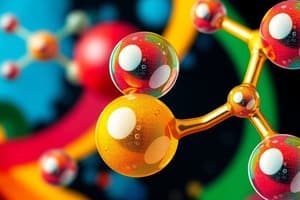Podcast
Questions and Answers
What type of bond is formed by electron transfer between atoms?
What type of bond is formed by electron transfer between atoms?
- Covalent Bond
- Double Bond
- Ionic Bond (correct)
- Hydrogen Bond
Which of the following is NOT typically present in organic compounds?
Which of the following is NOT typically present in organic compounds?
- Helium (correct)
- Hydrogen
- Oxygen
- Carbon
What classification does a bond formed between two atoms of different electronegativities fall under?
What classification does a bond formed between two atoms of different electronegativities fall under?
- Polar Covalent Bond (correct)
- Triple Bond
- Ionic Bond
- Non-Polar Covalent Bond
Which element is considered a trivalent atom in organic compounds?
Which element is considered a trivalent atom in organic compounds?
What type of bond consists of the sharing of electrons?
What type of bond consists of the sharing of electrons?
How many lone pairs of electrons are found in an oxygen atom?
How many lone pairs of electrons are found in an oxygen atom?
What defines a non-polar covalent bond?
What defines a non-polar covalent bond?
Which of these is an example of a double bond?
Which of these is an example of a double bond?
Flashcards are hidden until you start studying
Study Notes
Organic Chemistry
- Organic chemistry is the study of organic compounds.
- Organic compounds are primarily focused on the structure, properties, preparation, and reactions of carbon-containing molecules.
- Organic compounds encompass naturally occurring and synthetically produced substances.
Organic Compounds
- Organic compounds primarily contain carbon (C) along with other elements like hydrogen (H), oxygen (O), nitrogen (N), sulfur (S), chlorine (Cl), bromine (Br), and more.
- The four main elements in organic compounds are carbon, hydrogen, oxygen, and nitrogen.
Electronic Structure
- Atoms consist of a positively charged nucleus surrounded by negatively charged electrons residing in energy levels.
Carbon
- Carbon is a tetravalent atom, meaning it can form four covalent bonds.
Hydrogen
- Hydrogen is a monovalent atom, capable of forming one covalent bond.
Nitrogen
- Nitrogen is a trivalent atom, forming three covalent bonds.
Oxygen
- Oxygen is a divalent atom, forming two covalent bonds.
Lone Pairs
- Nitrogen atoms can have one lone pair of electrons, as seen in ammonia (NH3).
- Oxygen atoms typically have two lone pairs of electrons, as observed in water (H2O).
Free Electrons
- Free electrons are also known as non-bonding electrons.
Chemical Bonds
- Chemical bonds are categorized into two main groups: Structural (Constitutional) and Non-Structural (Non-Constitutional).
Structural Bonds
- Structural bonds are responsible for the overall arrangement of atoms within a molecule.
Ionic Bonds
- Ionic bonds are formed by the complete transfer of electrons between atoms.
- Ionic bonds involve the attraction between a positively charged cation and a negatively charged anion.
- Sodium chloride (NaCl) is a common example of an ionic compound.
Covalent Bonds
- Covalent bonds are formed by the sharing of electrons between atoms.
- Covalent bonding is the dominant type of bond found in organic molecules.
Classifying Covalent Bonds
- Covalent bonds can be classified based on the number of shared electron pairs:
- Single bond: One shared electron pair.
- Double bond: Two shared electron pairs.
- Triple bond: Three shared electron pairs.
Electronegativity
- Electronegativity is the ability of an atom to attract electrons toward itself in a chemical bond.
Non-Polar Covalent Bond
- Non-polar covalent bonds occur when the two bonded atoms are identical, such as in C-C and H-H bonds.
- Non-polar covalent bonds also arise when the electronegativity difference between the two atoms is very small, as seen in C-H bonds.
Polar Covalent Bond
- Polar covalent bonds form when the two bonded atoms have a significant electronegativity difference.
- Water (H2O) is a classic example of a polar molecule due to the electronegativity difference between oxygen and hydrogen.
- Polar molecules possess partial charges, but not full charges.
Studying That Suits You
Use AI to generate personalized quizzes and flashcards to suit your learning preferences.




